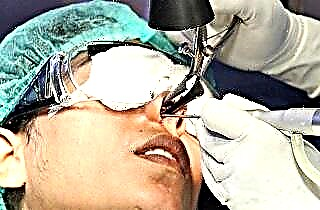The maxillary sinus (in another way it is called the sinus) performs very important functions. It warms and purifies the air during breathing, adapting it to the needs of our body. It is the maxillary sinuses that are the place where viruses and pathogenic microbes are retained. Therefore, the slightest failure in the correct operation of the maxillary sinus can lead to the appearance of inflammatory pathological processes, and they, in turn, to the formation of polyps.
Doctors around the world are sounding the alarm - polyps in the maxillary sinus at different stages of development are diagnosed in 15 percent of the world's population. Polypoid sinusitis is one of the ten most common ailments. In case of untimely or incorrect treatment, a rapid depletion of the mucous membrane occurs, which entails blocking the outlet. As a result, neoplasms emerge from the sinuses into the nasal cavity.
A bit of physiology
 The maxillary sinuses are located in the left maxillary and right maxillary bones (in the nose, on both sides of the wings). The sinuses are connected to the nasal cavity through special ducts. With their help, the body gets rid of mucus and is saturated with oxygen. In a normal state, a minimal amount of mucus enters the nose, which helps to cleanse the mucous membrane of allergens and other harmful compounds.
The maxillary sinuses are located in the left maxillary and right maxillary bones (in the nose, on both sides of the wings). The sinuses are connected to the nasal cavity through special ducts. With their help, the body gets rid of mucus and is saturated with oxygen. In a normal state, a minimal amount of mucus enters the nose, which helps to cleanse the mucous membrane of allergens and other harmful compounds.
When rhinitis occurs, inflammation and swelling of the ducts is observed and, as a result, a violation of the outflow of mucus. Pathogenic microbes begin to actively multiply in it, and as a result, sinusitis appears. If you miss the moment and allow the formation of pus, the inflammatory process becomes chronic.
Further, the disease can develop in two different ways - along the exudative direction and productive. With the latter option, the tissue structure of the mucous membrane changes, which leads to the formation of a polyp.
Polypoid sinusitis is a disease characterized by a sluggish pathology in the maxillary sinus. The source of the disease can be of an infectious or allergic origin. The key feature of this pathology is the polyps of the maxillary sinuses.
Polyps are nothing more than an enlarged mucous membrane, where, in addition to normal cells, connective tissue elements are present. They disrupt the mechanism of the respiratory process and are found to the same extent in both children and adults. There are various techniques to eliminate maxillary sinus polyps. But before starting treatment, you need to determine the symptoms and causes.
Symptoms and causes of the disease
Not always polypous sinusitis is preceded by an acute inflammatory process. It happens that the symptoms may not be expressed (in this case, the diagnosis is difficult enough). Sometimes the inflammation of one sinus quickly spreads to the healthy sinus. Thus, bilateral sinusitis appears.
Risk factors that contribute to the appearance of such an ailment include the following:
 increased sensitivity of the body to internal and environmental factors;
increased sensitivity of the body to internal and environmental factors;- rhinitis of the vasomotor type;
- bruises of the nose and trauma to the cranial bones;
- bronchial asthma and other allergic diseases;
- pathological change in the shape of the nasal concha;
- adenoids (inflamed nasopharyngeal tonsils);
- genetic predisposition;
- small width of the nasal passages and so on.
Polypoid sinusitis is a multifactorial disease. In other words, it is not possible to establish the exact cause of its appearance. And all of the above factors are in the nature of an assumption. At the same time, most researchers and doctors tend to consider the combination of allergization and a decrease in the body's immune defense as the main cause of such sinusitis.
Symptoms of polyposis sinusitis are as follows:
- periodic headaches with heaviness in the head;
- breathing through the mouth (the patient walks with his mouth ajar);
- violation of memory mechanisms;
- night cough that does not respond to standard drug treatment;
- periodic sneezing;
- a feeling of the presence of a foreign body in the nasal cavity;
- violation of taste;
- decreased olfactory function;
- purulent or mucous discharge from the nasal cavity;
- in some cases, fever, irritability, fatigue.
Treatment
 In most cases, conservative drug treatment is used, which is aimed at reducing the inflammatory process. In addition, it is necessary to slow down the growth rate of neoplasms (polyps). Unfortunately, full recovery from drugs does not occur, and polyps do not completely disappear. At the same time, medications can significantly slow down the progression of the disease.
In most cases, conservative drug treatment is used, which is aimed at reducing the inflammatory process. In addition, it is necessary to slow down the growth rate of neoplasms (polyps). Unfortunately, full recovery from drugs does not occur, and polyps do not completely disappear. At the same time, medications can significantly slow down the progression of the disease.
If symptoms are found and causes are identified, the following remedies are used:
- Antihistamines for allergies. We are talking about such drugs: "Desloratadin", "Tavegil", "Kromoglin", "Erius" and so on. They help reduce swelling and minimize inflammation.
- Another good option is to use a corticosteroid nasal medication. As a rule, doctors prescribe Fliksonase, Nasonex, Avamis and some other drugs. They fight well with swelling of the mucous membrane. As a result, purulent accumulations are removed from the maxillary sinuses. The growth of neoplasms is significantly slowed down and normal respiration returns.
- Medicines based on sea salt water have proven themselves well. These are, first of all, "Physiomer", "Morenazal", "Aqualor". They are used to flush the nasal cavity and remove pus and mucous accumulations.
- In some cases, doctors prescribe one of the types of antibiotics - systemic or local action. With polypous sinusitis, the patient can take "Albucid", "Polydex", "Amoxiclav" or "Bioparox". They contribute to the destruction of pathogenic microbes and foci of infection, completely eliminate purulent processes.
- Immunomodulatory drugs such as "Polyoxidonium", "Amiksin" and "Immunoriks" act as an excellent supplement. Such drugs help to increase immunity and make the body more actively fight infection.
- Also, in the process of drug treatment, a number of serums and vaccines are used. They act as immunotherapy and target bacterial pathogens that are insensitive to standard antibiotic therapy.
 In addition to these drugs, in the treatment of polypous sinusitis, a procedure is prescribed for rinsing the nose on a special device "Cuckoo" (rinsing is performed using "Miramistin", "Rivanol" and some other disinfectant solutions).
In addition to these drugs, in the treatment of polypous sinusitis, a procedure is prescribed for rinsing the nose on a special device "Cuckoo" (rinsing is performed using "Miramistin", "Rivanol" and some other disinfectant solutions).
There is also a more radical technique that involves surgery. If medications are ineffective and the symptoms of the disease have not disappeared, polyps can be removed using special loops. But this is an outdated technique, it has many disadvantages. In particular, such mechanical disposal is very painful and causes profuse bleeding. In addition, there is a high probability of incomplete removal of the polyp and relapse.
This radical method was replaced by more gentle ones, in particular - endoscopic elimination of polyps by means of a shaver or microderiber. This is not only less painful, but also more reliable.In some cases, a laser is used to fight small growths.
Polypoid sinusitis is not a disease that can be left to chance. This is a dangerous ailment that is fraught with many unpleasant complications.
If you find one of the symptoms described, immediately consult a doctor and get diagnosed. Eliminate frequent contact with allergens, eat right, regularly strengthen your immunity, and all diseases will bypass you.

 increased sensitivity of the body to internal and environmental factors;
increased sensitivity of the body to internal and environmental factors; In addition to these drugs, in the treatment of polypous sinusitis, a procedure is prescribed for rinsing the nose on a special device "Cuckoo" (rinsing is performed using "Miramistin", "Rivanol" and some other disinfectant solutions).
In addition to these drugs, in the treatment of polypous sinusitis, a procedure is prescribed for rinsing the nose on a special device "Cuckoo" (rinsing is performed using "Miramistin", "Rivanol" and some other disinfectant solutions).

